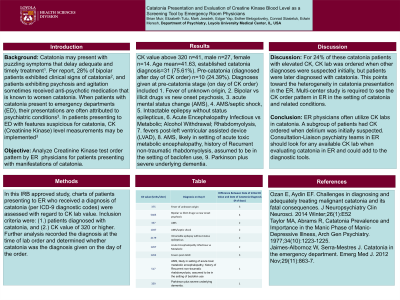Catatonia
Session: Poster Session
(011) Catatonia Presentation and Evaluation of Creatine Kinase Blood Level as a Screening Tool by Emergency Room Physicians

Trainee Involvement: Yes

Brian Muir, BA
Medical Student
Loyola University Chicago Stritch School of Medicine
Forest Park, Illinois, United States
Elizabeth Tutu, BS
Co-Author
Stritch School of Medicine
Oak Park, Illinois, United States- MJ
Mark Jaradeh
Medical Student
Loyola University Medical Center
Maywood, Illinois, United States 
Edgar Yap
Medical Student
Loyola University Chicago Stritch School of Medicine
Chicago, Illinois, United States- EB
Esther Belogolovsky
Medical student
Loyola University
Chicago, Illinois, United States .jpg)
Conrad Stasieluk, MD (he/him/his)
Resident-Physician
Loyola University Medical Center
Maywood, Illinois, United States- EM
Edwin Meresh, MD, MPH, FACLP
Professor of Psychiatry
Loyola University Medical Center
Maywood, Illinois, United States
Presenting Author(s)
Co-Author(s)
Background: Catatonia may present with puzzling symptoms that delay adequate and timely treatment1. Per report, 28% of bipolar patients exhibited clinical signs of catatonia2, and patients exhibiting psychosis and agitation sometimes received anti-psychotic medication that is known to worsen catatonia. When patients with catatonia present to emergency departments (ED), their presentations are often attributed to psychiatric conditions3. In patients presenting to ED with features suspicious for catatonia, CK (Creatinine Kinase) level measurements may be implemented3.
Objective: Analyze Creatinine Kinase test order pattern by ER physicians for patients presenting with manifestations of catatonia.
Methods: In this IRB approved study, charts of patients presenting to ER who received a diagnosis of catatonia (per ICD-9 diagnostic codes) were assessed with regard to CK lab value. Inclusion criteria were: (1.) patients diagnosed with catatonia, and (2.) CK value of 320 or higher. Further analysis recorded the diagnosis at the time of lab order and determined whether catatonia was the diagnosis given on the day of the order.
Results: CK value above 320 n=41, male n=27, female n=14. Age mean=41.63, established catatonia diagnosis=31 (75.61%). Pre-catatonia (diagnosed after day of CK order) n=10 (24.39%). Diagnoses given at pre-catatonia stage (on day of CK order) included 1. Fever of unknown origin, 2. Bipolar vs illicit drugs vs new onset psychosis, 3. acute mental status change (AMS), 4. AMS/septic shock, 5. Intractable epilepsy without status epilepticus, 6. Acute Encephalopathy Infectious vs Metabolic, 7. Alcohol Withdrawal; Rhabdomyolysis, 8. fevers post-left ventricular assisted device (LVAD), 9. AMS, likely in setting of acute toxic metabolic encephalopathy, history of Recurrent non-traumatic rhabdomyolysis, assumed to be in the setting of baclofen use, 10. Parkinson plus severe underlying dementia.
Discussion: For 24% of these catatonia patients with elevated CK, CK lab was ordered when other diagnoses were suspected initially, but patients were later diagnosed with catatonia. This points toward the heterogeneity in catatonia presentation in the ER. Multi-center study is required to see the CK order pattern in ER in the setting of catatonia and related conditions.
Conclusion: ER physicians often utilize CK labs in catatonia. A subgroup of patients had CK ordered when delirium was initially suspected. Consultation-Liaison psychiatry teams in ER should look for any available CK lab when evaluating catatonia in ER and could add to the diagnostic tools.
References:

